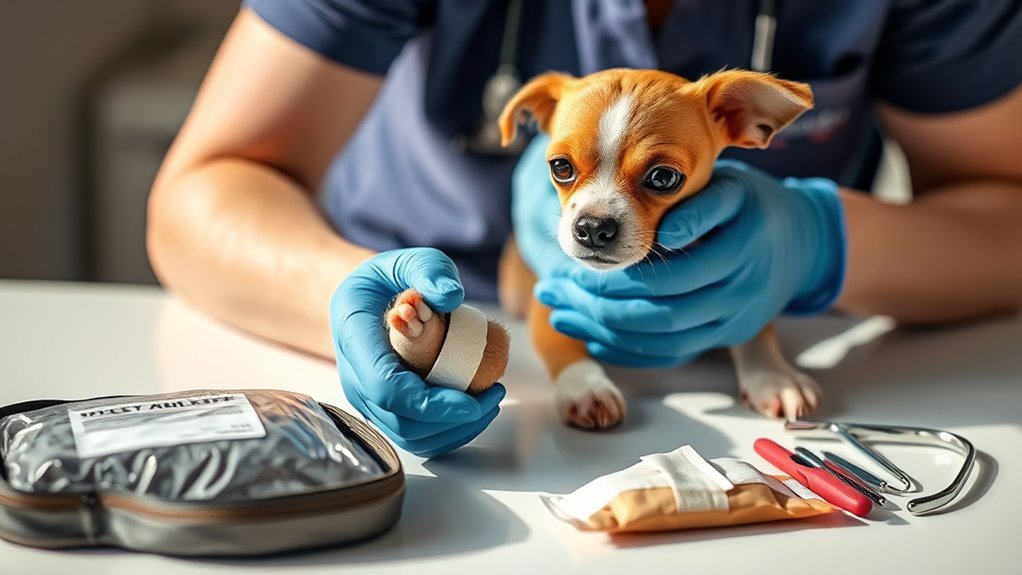Knowing pet first aid basics can help you act quickly and confidently during emergencies. Learn essential skills like pet CPR, recognizing toxic substances, and how to respond to injuries or poisoning. Keep a well-stocked first aid kit and store harmful items safely out of your pet’s reach. Staying calm and prepared can make a big difference in your pet’s survival and recovery. Keep going to discover more tips to protect your furry friend when it matters most.
Key Takeaways
- Learn pet CPR techniques, including proper chest compression placement and rhythm, to effectively respond during emergencies.
- Recognize signs of poisoning and act quickly by contacting a veterinarian or poison control for prompt assistance.
- Maintain a well-stocked pet first aid kit with essentials like gauze, antiseptics, and thermometers for immediate care.
- Practice poison prevention by storing toxic substances securely and being aware of common household hazards.
- Stay calm, act swiftly, and acquire basic first aid knowledge to improve emergency outcomes and protect your pet’s health.

Knowing basic pet first aid can make all the difference in an emergency. When your pet suddenly shows signs of distress, quick and confident action can save their life. One of the most important skills to learn is CPR techniques tailored for animals. Unlike humans, pets have different breathing and heartbeat rates, so understanding how to perform chest compressions and rescue breaths correctly is essential. For dogs and cats, you’ll need to position them properly—lying on their side for chest compressions—and apply steady, rhythmic pressure with your hands. If your pet isn’t breathing or has no heartbeat, performing CPR immediately can help maintain critical circulation until professional help arrives. Practice makes perfect, so consider taking a pet first aid course to familiarize yourself with the proper technique. Understanding the differences in physiology is crucial for effective pet CPR.
Knowing pet first aid, especially CPR, can save your pet’s life in emergencies.
Poison prevention is equally essential in pet first aid. Many common household items, plants, and foods are toxic to pets, so you must be proactive in keeping dangerous substances out of their reach. Store cleaning supplies, medications, and human foods like chocolate, grapes, or onions securely away from your pet’s access. Keep a list of toxic substances handy, and learn to recognize symptoms of poisoning, such as vomiting, diarrhea, drooling, or difficulty breathing. If you suspect your pet has ingested something harmful, don’t wait—contact your veterinarian or an emergency pet poison hotline immediately. Quick action can prevent more serious health issues and even save your pet’s life.
In addition to knowing how to perform CPR and practicing poison prevention, you should also be prepared with a well-stocked pet first aid kit. Include items like gauze, antiseptic wipes, tweezers, and a digital thermometer. Regularly check the kit to make sure everything is in good condition and replace any used or expired supplies. Being organized and prepared means you’ll be ready to handle minor injuries or emergencies efficiently.
Understanding the basics of pet first aid doesn’t mean you have to be a veterinarian, but it does mean you’re ready to act confidently when it matters most. Learning CPR techniques tailored for pets and taking steps toward poison prevention can greatly impact your pet’s safety. Remember, staying calm and acting swiftly are your best tools in any emergency. Your knowledge and preparedness can make all the difference in protecting your furry friend’s health and well-being during unexpected situations.
Frequently Asked Questions
How Can I Tell if My Pet Is in Pain?
You can tell if your pet is in pain by observing changes in their behavior and pain indicators. Look for signs like limping, whimpering, hiding, or loss of appetite. Notice if they’re unusually aggressive or lethargic. These pain indicators help you identify when your pet needs prompt attention. Staying attentive to their normal behavior and any deviations can make a big difference in providing timely care.
What Are Common Signs of Poisoning in Pets?
Did you know that around 50% of pet poisonings involve household chemicals? If your pet shows signs like vomiting, diarrhea, drooling, tremors, or difficulty breathing, they could be poisoned. You should immediately check for toxic plant identification and household chemical safety hazards. Act quickly, keep your pet calm, and contact your veterinarian or a pet poison control center to guarantee prompt treatment and prevent serious health issues.
How Do I Perform CPR on a Dog or Cat?
In a dog rescue situation, performing CPR is vital. First, guarantee pet airway management by checking the mouth for obstructions and clearing debris. If the pet isn’t breathing, position them on their side, and start chest compressions with firm, rhythmic presses about 1/3 the depth of their chest. Keep airway open with gentle head tilt, and give rescue breaths if trained. Stay calm, act quickly, and seek veterinary help immediately.
When Should I Seek Emergency Veterinary Care?
Like a captain spotting storm clouds, you should seek emergency veterinary services immediately when your pet shows signs of severe distress—such as difficulty breathing, unresponsiveness, bleeding, or sudden collapse. Prioritizing pet emergency preparedness helps you respond swiftly. Don’t wait—quick access to veterinary emergency services can be lifesaving. Trust your instincts, and when in doubt, get your pet checked out to ensure their safety and well-being.
What Items in My Home Are Dangerous to Pets?
You should be aware that household toxins can be dangerous to your pets, so pet proofing tips are essential. Items like cleaning supplies, human medications, plants, and certain foods are common household toxins. Keep these out of reach or in locked cabinets, and regularly check your home for potential hazards. Staying vigilant and pet proofing your space helps prevent accidental poisoning and keeps your furry friends safe.
Conclusion
So there you have it—your crash course in pet first aid. Now, armed with this knowledge, you’re practically the superhero your furry friend never knew they needed. Just don’t get too smug if you manage to save the day; after all, it’s only a matter of time before Fluffy chews something again. Stay alert, stay prepared, and remember: in the world of pets, chaos is just another day’s adventure.









